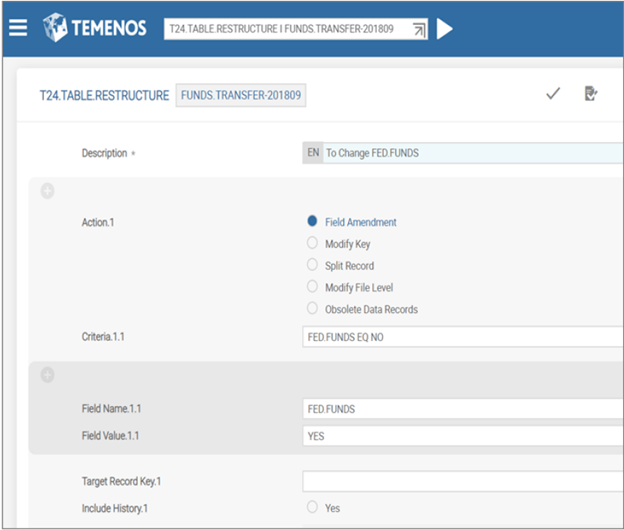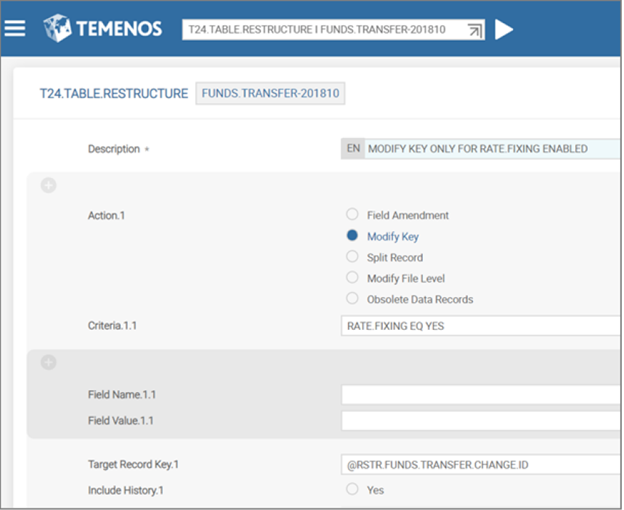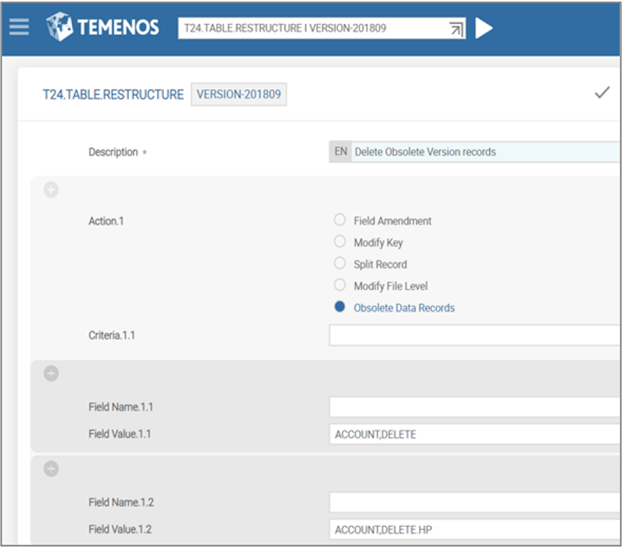Restructure operations
This section provides you the detailed description of the different operations that takes place during the restructure mechanism in an online upgrade process.
The table below shows the purpose and scenarios of the operations that takes place during the restructuring phase.
|
Restructure Operations |
Description |
Scenario |
|---|---|---|
|
Change the field value of a data record |
You may want to change or clear a field value. The field value can be a calculated value or constant value. This can happen based on criteria. |
A particular field in a table needs to be updated with TODAY in higher release. |
|
Modify the reference of a data rcord |
You can change the key or ID of an existing data records in a table. This is often done to avoid performance issues. You can perform this operation through a user exit. |
A product wants to change the ID of an existing entry of a table to have session number at the end to avoid locking contention. |
|
Split a data record |
You can clear a set of fields and move them to another record in same table with different ID. You can perform this operation through a user exit. |
A product wants to extract a certain multi-value sets from a record in a table to a new record with different ID. |
|
Remove a data record |
You can remove a record from a table that matches criteria. |
Temenos wants to remove a set of BATCH records which are no longer required in higher release. |
|
Change the file level |
A table sometimes changes level. This means physically you create multiple tables and move the records to a new set of tables. |
An INT type table can be re-classified as FIN (finance) to support multi company requirements. |
Change the field value of a data record
This operation aims to change an existing field value. Based on a criteria, it identifies the records and updates the field values to fix bugs.
See the below example to understand this operation.

- In the T24.TABLE.RESTRUCTURE record, the Field Amendment option is selected as the action item.
- Criteria is optional. If you are not specifying criteria, then restructure service will apply the field amendment operation to all the data items of the table.
- Field Name is mandatory. It has the following properties:
- Can be of any type.
- Should be a valid field name in the STANDARD.SELECTION record.
- Local reference field is applicable with exact name.
- Field Value can be a null, constant, valid system variable or routine.
- If you are providing Field Value as a routine, then ensure that this routine should have an entry in EB.API and routine name should be RSTR.(Table_name).(any_name). Where, Table_name should be similar to the first component in ID part.
- The routine arguments are Argument 1 [IN] – Current record, Argument 2 [IN] – Current record id and Argument 3 [OUT] – Expected field value.
- If you do not specify Field Value, it becomes null in that record.
Modify the reference of a data record
This operation aims to change the key or ID of an existing data record. It helps to improve the system performance.
See the below example to understand this operation.

- In the T24.TABLE.RESTRUCTURE record, the Modify Key option is selected as the action item.
- Criteria is optional. If you are not specifying criteria, then restructure service will apply the Modify Key operation to all the data items of the table.
- The new ID or key is decided based on Target Record Key. This Target Record Key can hold a constant or hook routine.
- If you are providing Target Record Key as a routine, then ensure that this routine should have an entry in EB.API and routine name should be RSTR.(Table_name).(any_name). Where, Table_name should be similar to the first component in ID part.
- The routine arguments are Argument 1 [IN] – Application name, Argument 2 [IN] – Current Data record and Argument 3 [IN or OUT] – Current record ID changes to target ID and returns to restructure service for further process. You can also frame the target ID based on the field value of current data record from Argument 2 [IN].
Split a data record
This operation aims to split a record into two different records in the same table. It is rarely used. Use this operation, when you cannot use a record in the new Temenos Transact release.
See the below example to understand this operation.
- In the T24.TABLE.RESTRUCTURE record, the Split Record option is selected as the action item.
- The Target Record Key field is mandatory with a hook routine as its value.
- New record ID is retrieved based on the hook routine specified in Target Record Key.
- The routine should have an entry in EB.API and name should be RSTR.(Table_name).(any_name). Where, Table_name should be similar to the first component in ID part.
- The routine arguments are Argument 1 [IN] – Application name, Argument 2 [IN or OUT] – Current Data record, Argument 3 [IN] – Current record ID, Argument 4 [OUT] – Target record after split and Argument 5 [OUT] – Target record ID, i.e. new record ID.
Remove a data record
This operation aims to remove a record when it is invalid at the new release level. You can also remove a set of records based on the defined criteria.
You can use the sub value field Criteria to define multiple criteria for this restructure operation.
See the below example to under this operation.

- In the T24.TABLE.RESTRUCTURE record, the Obsolete Data Records option is selected as the action item.
- You can delete data records based on values specified in Criteria or Field Value.
You cannot specify a value in Criteria and Field Value at the same time.
Modify file level
This operation helps you to change an existing level of a table. You can enhance multi-company support by changing the existing level of a table to financial level physical table.
See the below example to understand this operation.
- In the T24.TABLE.RESTRUCTURE record, the Modify File Level option is selected as the action item.
- You can modify only INT level tables to FIN (financial) level tables.
- You should not provide ID of a type or level other than INT.
- If you do not provide a value in Field Value, it will default to FIN.
In this topic